October 11, 2019 | Deborah Kotz
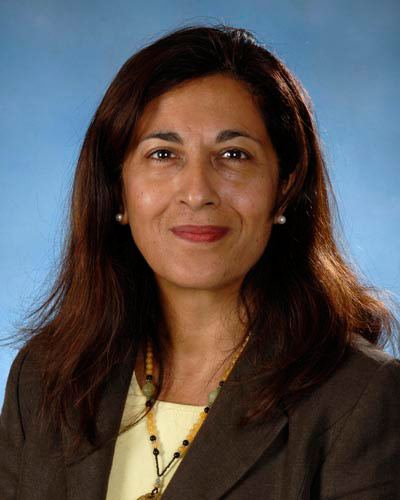
University of Maryland School of Medicine Researchers Find Two Drugs Work Together to Disrupt Cancer Cells’ Ability to Survive
In continuing efforts to find novel ways to kill cancer cells, researchers at the University of Maryland School of Medicine (UMSOM) have identified a new pathway that leads to the destruction of cancer cells. The new finding, published this week in the journal PNAS, could pave the way for the broader use of a class of anticancer drugs already on the market. These drugs, known as PARP inhibitors, are currently approved by the FDA to treat only a limited group of breast and ovarian cancers associated with BRCA gene mutations.
In a proof of concept study, the researchers demonstrated that combining a PARP inhibitor with a DNA methyltransferase (DNMT) inhibitor delivered a one-two punch to non-small cell lung cancer tumors, which are normally not associated with mutations in BRCA genes. The research, conducted in mouse models and cell lines, outlines the mechanistic action of the combination. The DNMT inhibitor triggers an effect that mimics a BRCA mutation in the cancer cell so the cell responds to the lethal effects of the PARP inhibitor, which prevents repair of damage to a tumor cell’s DNA, triggering cell death.
“When combined, these agents cause interactions that significantly disrupt cancer cells' ability to survive DNA damage,” said study senior author, Feyruz V. Rassool, PhD, professor of radiation oncology at UMSOM. “Our findings could expand the use of PARP inhibitors beyond the minority of inherited cancers that it now treats.”
Those who inherit two copies of a normal BRCA gene enjoy protection from DNA damage that can cause healthy cells to turn malignant. Those who inherit a mutation in this gene, however, have a higher risk of breast and ovarian cancer (in women) and prostate cancer (in men). Researchers have previously demonstrated that tumors that share molecular features of BRCA-mutant tumors – those with so-called “BRCAness” – respond to PARP inhibitor drugs designed to target tumors that arise from BRCA mutations. This new study from UMSOM is the first to demonstrate that cells can be induced to have a BRCAness phenotype or gene expression that is not the result of a mutation by treating them with the DNA methyltransferase inhibitor drug.
DNMT inhibitors suppress DNA methylation, which leads to changes in gene expression that significantly interfere with cancer cell growth. They are FDA-approved for use in myelodysplastic syndromes (cancers of the bone marrow),but are not usually combined with PARP inhibitors. Stephen Baylin, MD, Chief of Cancer Biology at Johns Hopkins University School of Medicine and graduate student Michael Topper at Johns Hopkins University, key collaborators in this study, have expertise in the action of these drugs.
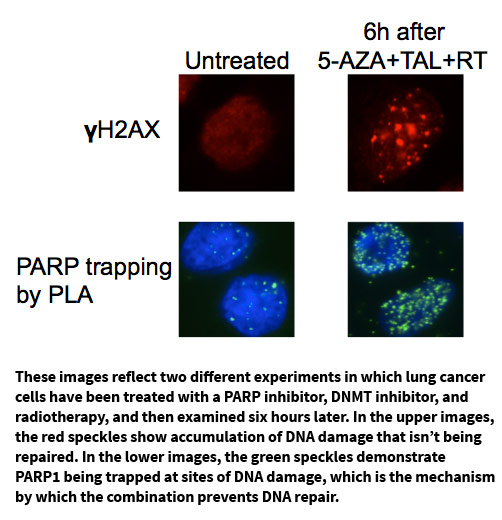 The researchers also found that the DNMT and PARP inhibitor combination prevented cancer cells from repairing the DNA damage caused by radiation, a common treatment for lung cancer. “We are very excited by the new finding because it explains the mechanistic action of this drug combination, which we found has a synergistic effect, and so works better than either drug alone,” said Rachel Abbotts, MD PhD, a postdoctoral fellow in the Department of Radiation Oncology who is the first author of the paper. “When we combined with radiation therapy, which is the standard treatment for lung cancer, we measured an even bigger effect.”
The researchers also found that the DNMT and PARP inhibitor combination prevented cancer cells from repairing the DNA damage caused by radiation, a common treatment for lung cancer. “We are very excited by the new finding because it explains the mechanistic action of this drug combination, which we found has a synergistic effect, and so works better than either drug alone,” said Rachel Abbotts, MD PhD, a postdoctoral fellow in the Department of Radiation Oncology who is the first author of the paper. “When we combined with radiation therapy, which is the standard treatment for lung cancer, we measured an even bigger effect.”
The researchers are now aiming to test this protocol in an early phase trial in patients with non-small cell lung cancer that will be conducted in coordination with the Marlene and Stewart Greenebaum Comprehensive Cancer Center. Two years ago, Dr. Rassool and her research team demonstrated that this novel drug combination worked to disrupt cancer cells in acute myeloid leukemia and they are now testing the protocol in a trial of cancer patients with AML. Early results suggesthat this drug combination is well tolerated.
“Finding a new paradigm to attack cancer cells is very exciting, especially when researchers can make use of drugs that are already on the market and have been well tested for efficacy and toxicity,” said E. Albert Reece, MD, PhD, MBA, Executive Vice President for Medical Affairs, UM Baltimore, and the John Z. and Akiko K. Bowers Distinguished Professor and Dean, University of Maryland School of Medicine. "We are committed to translational research, and this is excellent example of how we are able to move an important scientific discovery from the laboratory into the practice where it may potentially benefit patients."
The research, which builds on previous work by Dr. Rassool and Dr. Baylin, was funded by a number of grants, including Stand Up To Cancer's inaugural Laura Ziskin Prize in Translational Research – a $250,000 grant awarded to the two researchers in 2012. Ziskin, a Hollywood film producer who died of metastatic breast cancer, was a co-founder of Stand Up 2 Cancer, an initiative founded in 2008 by nine women in the entertainment industry to accelerate groundbreaking research and bring new treatments to patients as quickly as possible. Funding for this work has continued through the Van Andel Research Institute-SU2C.
About the University of Maryland School of Medicine
Now in its third century, the University of Maryland School of Medicine was chartered in 1807 as the first public medical school in the United States. It continues today as one of the fastest growing, top-tier biomedical research enterprises in the world -- with 43 academic departments, centers, institutes, and programs; and a faculty of more than 3,000 physicians, scientists, and allied health professionals, including members of the National Academy of Medicine and the National Academy of Sciences, and a distinguished recipient of the Albert E. Lasker Award in Medical Research. With an operating budget of more than $1 billion, the School of Medicine works closely in partnership with the University of Maryland Medical Center and Medical System to provide research-intensive, academic and clinically based care for more than 1.2 million patients each year. The School has over 2,500 students, residents, and fellows, and more than $540 million in extramural funding, with most of its academic departments highly ranked among all medical schools in the nation in research funding. As one of the seven professional schools that make up the University of Maryland, Baltimore campus, the School of Medicine has a total workforce of nearly 7,000 individuals. The combined School and Medical System (“University of Maryland Medicine”) has an annual budget of nearly $6 billion and an economic impact more than $15 billion on the state and local community. The School of Medicine faculty, which ranks as the 8th highest among public medical schools in research productivity, is an innovator in translational medicine, with 600 active patents and 24 start-up companies. The School works locally, nationally, and globally, with research and treatment facilities in 36 countries around the world. Visit medschool.umaryland.edu
Contact
Department of Anesthesiology
(410) 328-6120 (phone)
(410) 328-5531 (fax)
swalsh@som.umaryland.edu
Deborah Kotz
Director of Media Relations
Office of Public Affairs & Communications
University of Maryland School of Medicine
o: 410-706-4255
c: 410-804-0054
t: @debkotz2
Related stories
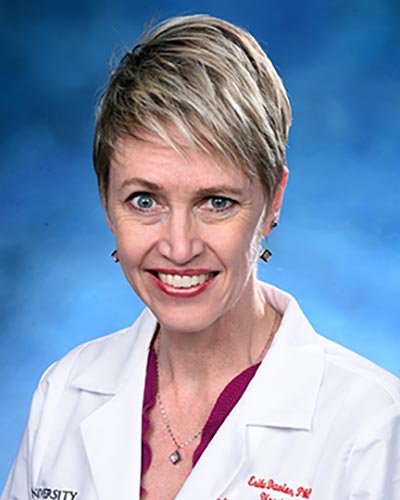
Monday, February 26, 2024
UM School of Medicine Awarded $3.5 Million in Federal Funding to Expand Medical Countermeasures Program
University of Maryland School of Medicine (UMSOM) Dean Mark T. Gladwin, MD, announced today that UMSOM faculty scientists have been selected as key contractors by the Biomedical Advanced Research and Development Authority (BARDA), for the federal agency’s Radiation Nuclear Animal Model Development program. The $3.5 million award that Erika Davies, PhD, Assistant Professor of Radiation Oncology, received to develop Acute Radiation Syndrome Animal Models, has a $16 million potential total. The Division of Translational Radiation Sciences (DTRS), within the Department of Radiation Oncology, will support this project.

Tuesday, July 14, 2020
UM School of Medicine Researchers Identify Mechanism for Treating Cancer Cells
Researchers at the University of Maryland School of Medicine (UMSOM) have identified a surprising new mechanism that may significantly expand use of an important cancer drug, called a PARP inhibitor. These drugs are currently only approved to be used in those with certain mutations in the BRCA1 or BRCA2 genes that are associated with breast and ovarian cancers. The new findings were published online last week in the Proceedings of the National Academy of Science (PNAS) journal in collaboration with a group at Johns Hopkins School of Medicine.
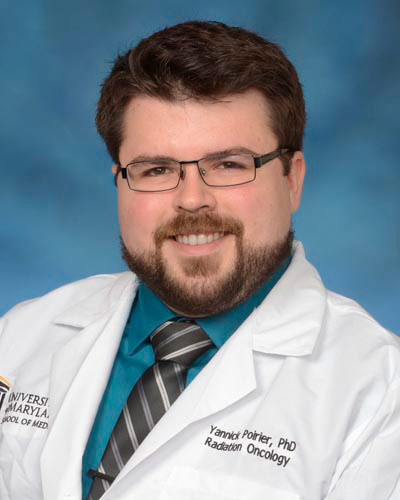
Wednesday, July 31, 2019
Inconsistent Reporting of Methodologies Makes Most Radiation Biology Studies Impossible to Replicate
Nearly 80 percent of radiation oncology studies funded by the National Institutes of Health involve investigating the effects that radiation has on tumor cells and healthy tissue in pre-clinical settings, such as experiments done in cell cultures or mice. A majority of these radiation biology studies, however, have serious flaws in how their irradiation methodology is described, which makes them very difficult to replicate, according to a new finding from the University of Maryland School of Medicine (UMSOM).

Tuesday, February 19, 2019
Dr. Robert C. Miller, National Leader in Radiation Oncology, Named New Medical Director of Maryland Proton Treatment Center
William F. Regine, MD, FACR, FACRO, The Isadore and Fannie Schneider Foxman Chair and Professor of Radiation Oncology at the University of Maryland School of Medicine (UMSOM), along with UMSOM Dean E. Albert Reece, MD, PhD, MBA, announced today that Robert C. Miller, MD, MBA, FASTRO a nationally-recognized radiation oncologist who currently serves as Vice Chair in the Department of Radiation Oncology at the Mayo Clinic, has been named Professor in the UMSOM Department of Radiation Oncology and Medical Director of the Maryland Proton Treatment Center (MPTC). He will begin his new position in April 2019.
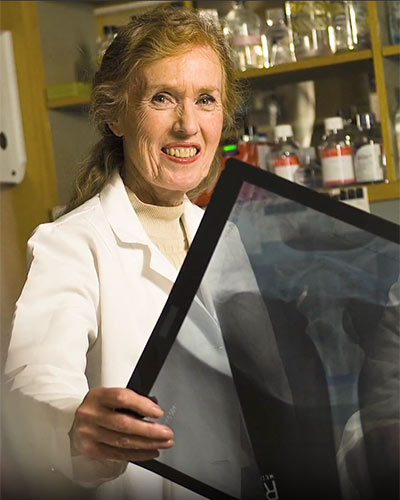
Monday, October 29, 2018
UMSOM Honors Breast Cancer Awareness Month, Our Research Continues Toward Combating this Disease
October is Breast Cancer Awareness Month, and researchers at the University of Maryland School of Medicine (UMSOM) continue in their work to help combat this disease that impacts more than 315,000 women in the U.S. each year.
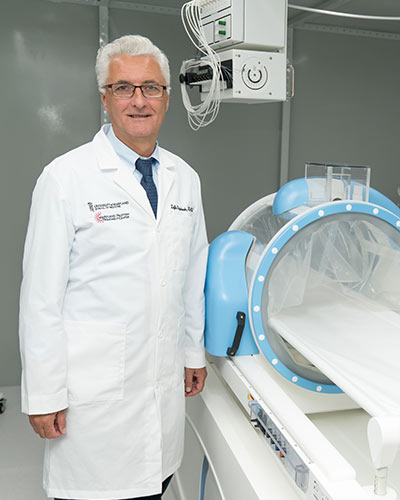
Monday, October 08, 2018
High-Precision Proton Therapy More Effective in Treating Certain Cancers When Combined with Thermal Therapy
The Maryland Proton Treatment Center (MPTC) is now offering deep-tissue external thermal therapy in combination with high-precision proton-beam radiotherapy as a potential way to boost survival chances for certain cancer patients. MPTC is the only center in the world to offer these two treatments at the same facility, an advantage to patients because these therapies are typically given within an hour of each other.
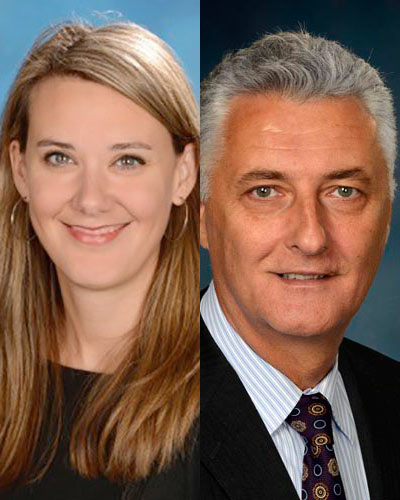
Monday, September 24, 2018
University of Maryland School of Medicine Researchers to Present Original Research at Key Radiation Conference
The University of Maryland School of Medicine (UMSOM) announced that the Division of Translational Radiation Science (DTRS) will participate in the annual meeting of the Radiation Research Society (RRS) on September 23-26, 2018, in Chicago.
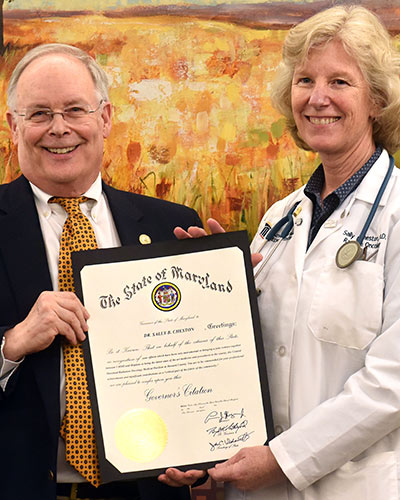
Monday, May 14, 2018
Gov. Larry Hogan Recognizes Achievements of Sally B. Cheston, MD, of Central Maryland Radiation Oncology Center
Maryland Gov. Larry Hogan today recognized Sally B. Cheston, MD, an assistant professor of radiation oncology at the University of Maryland School of Medicine (UMSOM), for her efforts to bring the “latest state-of-the-art medicine” to Howard County as a leader of the Central Maryland Radiation Oncology Center (CMRO).

Wednesday, May 10, 2017
How Cancer Turns a Good Protein Into A Double Agent
Under normal conditions, the CHD4 protein is helpful: it stops cells from transcribing faulty DNA, thereby eliminating potential mutation. However, in colon cancer and perhaps other kinds of cancer as well, it appears that this protein becomes a kind of double agent, working for the enemy.

Tuesday, October 11, 2016
Researchers Identify Novel Mechanism In Combination Drug Therapy For Acute Myeloid Leukemia, Other Cancers
Researchers have discovered a novel mechanism in a combination drug therapy that shows potential as a new approach for treating acute myeloid leukemia (AML) and many other cancers. When combined, these agents cause interactions that significantly disrupt cancer cells’ ability to survive DNA damage, according to a preclinical study published today in the journal Cancer Cell.
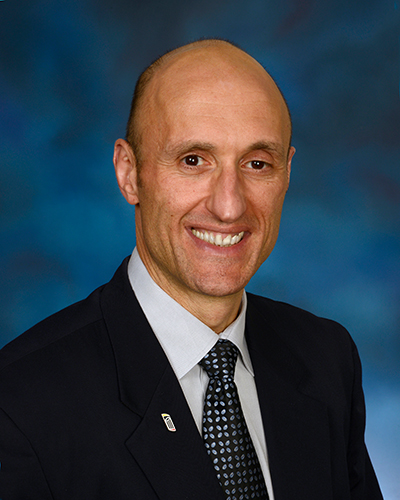
Friday, January 15, 2016
UM SOM to Participate in Expanded Medical Countermeasures Research Project
University of Maryland School of Medicine (UM SOM) Department of Radiation Oncology Chair and Professor William F. Regine, MD, FACR, FACRO, and UM SOM Dean E. Albert Reece, MD, PhD, MBA, announced today that researchers at the UM SOM have been selected as key contractors by the Biomedical Advanced Research and Development Authority (BARDA), for its Radiation Nuclear Animal Model Development program. BARDA is part of the Office of the Secretary for Preparedness and Response in the U.S. Department of Health and Human Services (DHHS).
